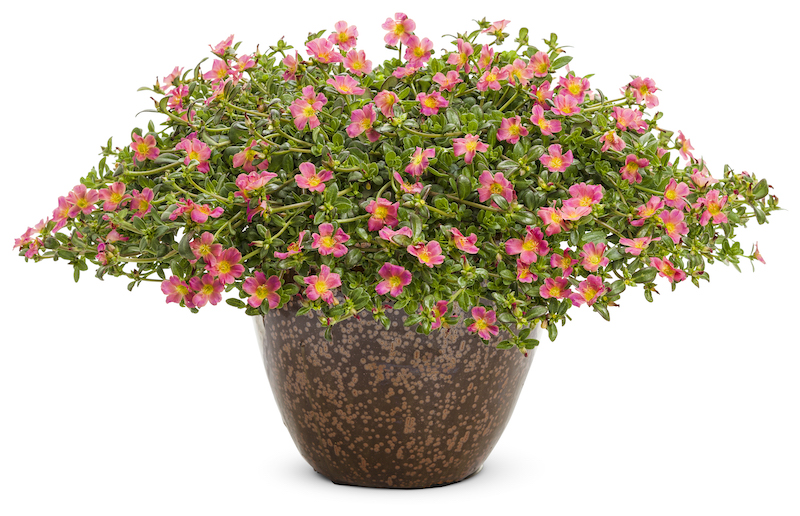Purslane is a flowering succulent used as a carpet-like ground cover or as a spiller in a container or hanging basket. Often grown as an annual, Purslane thrives in warm, sunny weather. This plant does not have many pests, but there are some likely culprits that can cause problems in certain areas. Purslane sawfly (Schizoporella pilicornis) and leafminer weevil (Hypurus bertrand perris) are some pests that damage Purslane. Controlling infestation is essential to preventing problems and growing healthy Purslane.

Common Purslane Pests
Purslane Sawfly
Purslane sawfly, or Schizocerella pilicornis, is a tiny insect that exclusively feeds on Purslane plants during its larvae stage. The grub-like larvae begin eating Purslane foliage as soon as they emerge from their egg. The insects tunnel into a leaf and destroy it from within, creating a blotch leaf mine. Purslane sawfly damage appears as white lines and black spots that spread out on an entire leaf. One sawfly can lay several dozen eggs, and these insects have a short lifespan, so there can be several generations of Purslane sawflies in a single growing season.
Treating Purslane Sawfly on Purslane
The quickest way to treat Purslane sawflies is to remove and destroy damaged leaves. After the larvae feed on the plant, they move to the soil and enter the pupae stage before emerging as adults and laying eggs. After removing foliage with leaf mine damage, till the surrounding soil to disrupt and destroy Purslane sawflies in the pupae stage.
Spray the plant with an insecticide or horticultural oil to treat Purslane sawflies. These products will kill eggs or larvae that have yet to damage the foliage. It may take several weeks of treatment since Purslane sawflies have a short lifespan, and multiple generations of insects could infest the plant.
Preventing Purslane Sawfly on Purslane
Purslane sawflies only target Purslane plants, which is good news for your other plants, but it also makes it more challenging to prevent this pest since you cannot remove a food source without getting rid of the plant. Routinely spray the plant with horticultural oil to prevent sawflies. Misting the plant will discourage adult sawflies from laying eggs. Routinely inspect the plant for signs of damage.
Leafminer Weevil
Hypurus bertrand perris is a leafminer weevil that targets Purslane. The leafminer larvae tunnel into the leaves and eat them from within. White lines on the exterior of the leaf show the path the larvae took as they worked their way through the leaves. After feeding, the larvae exit the foliage and transition into beetles, known as weevils.
Treating Leaf Miner Weevil on Purslane
Leaf Miner infestation can be damaging to Purslane. One leafminer weevil can lay dozens of eggs, and an entire family of insects can kill a plant in weeks. Remove foliage with signs of leaf-mining damage right away. Destroy the damaged leaves to kill the larvae and prevent them from reaching adulthood and producing more eggs. Treating leaf miner weevils by removing leaves is a long process, and it may take several weeks to get the infestation under control.
Preventing Leafminer Weevil on Purslane
Prevent leafminer weevils from infesting Purslane by spraying the plant with horticultural oil or insecticide. Treatment will destroy eggs and larvae that have yet to be spotted and prevent more insects from infesting the plant. Spray the plant monthly and routinely inspect the plant for signs of damage. Along with removing damaged leaves, increase the spraying frequency to weekly if you spot leaf-mining damage.
Purslane Pests Chart
|
Pest |
Identifying |
Treating |
|
Purslane Sawfly |
Small, green caterpillar-like insects with a slightly translucent body and a dark head |
Remove and destroy damaged leaves |
|
Leafminer Weevil |
Tiny, legless grubs that are white or pale yellow and create serpentine mines within leaves |
Remove and destroy foliage with signs of leaf-mining damage right away |
Sources:
"Common Purslane, Portulaca oleracea." University of Wisconsin-Madison’s Extension Horticulture Program. hort.extension.wisc.edu
"Purslane." Prairie View A&M University. pvamu.edu
 |
Author Alison Cotsonas - Published 04-20-2023 |
